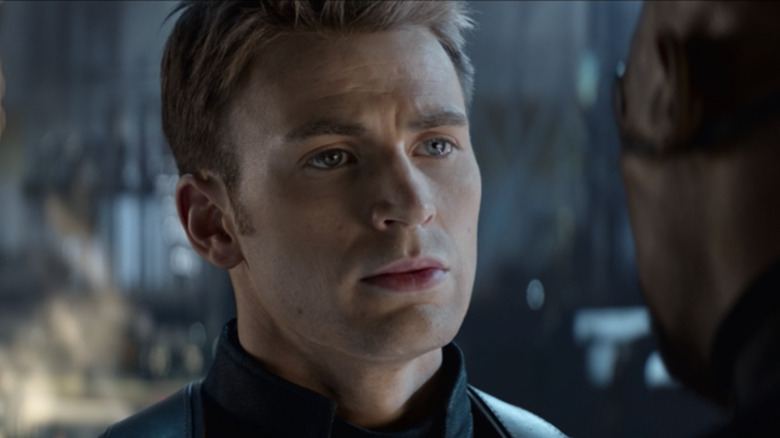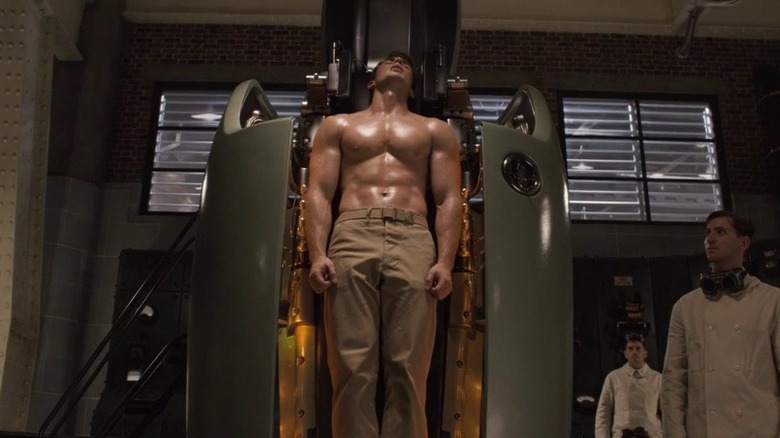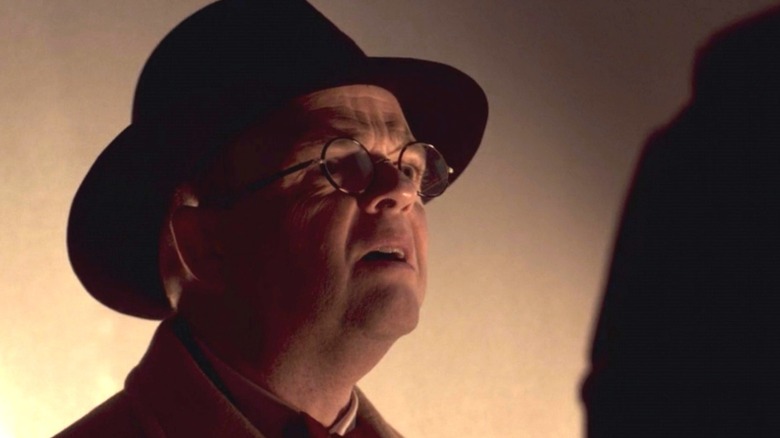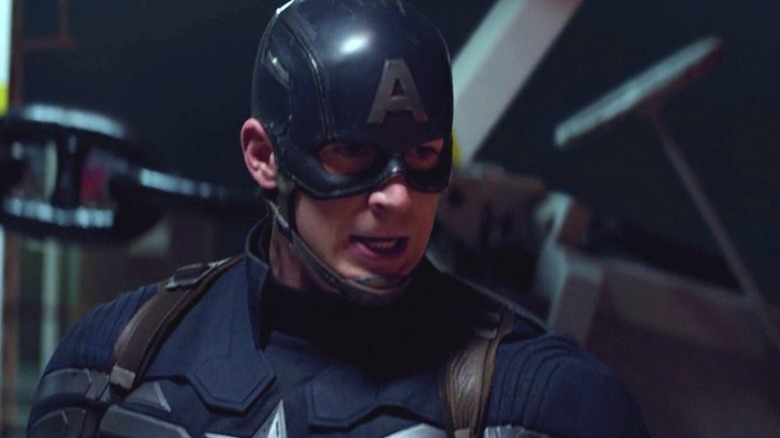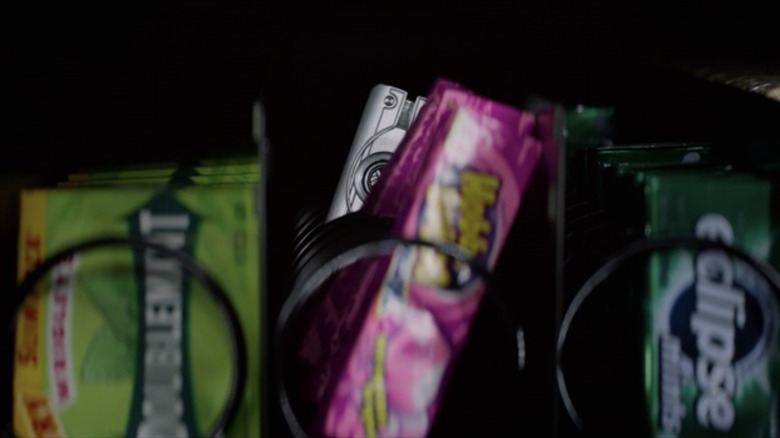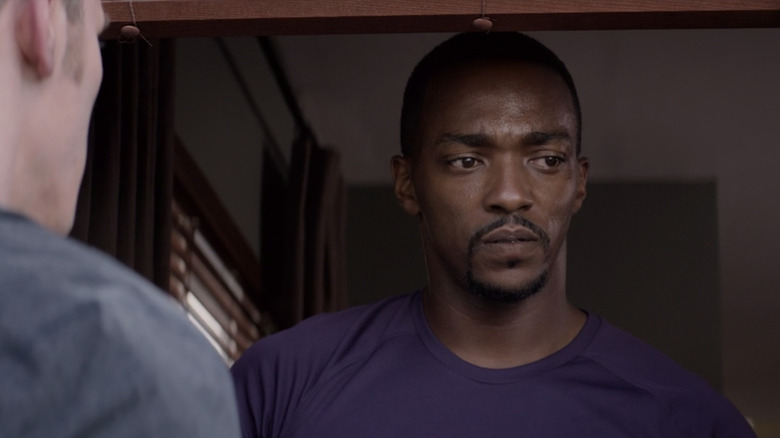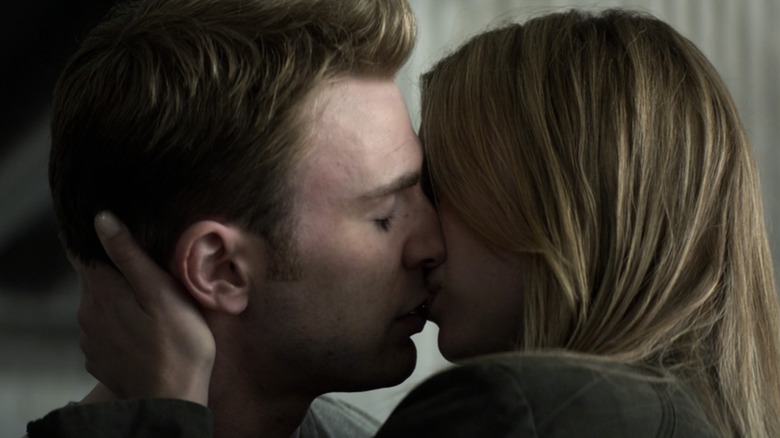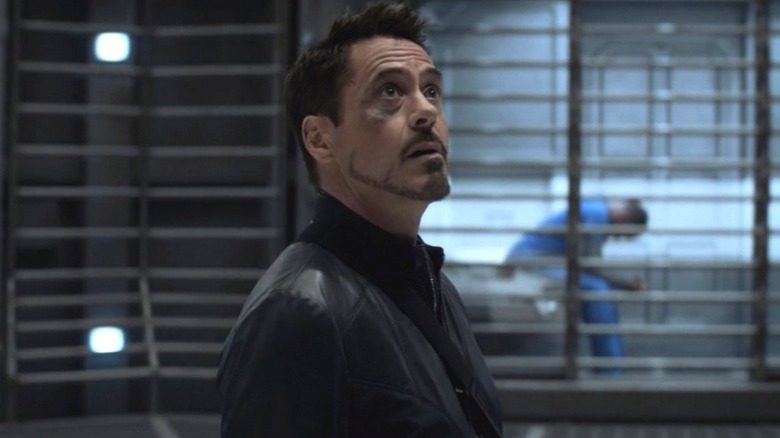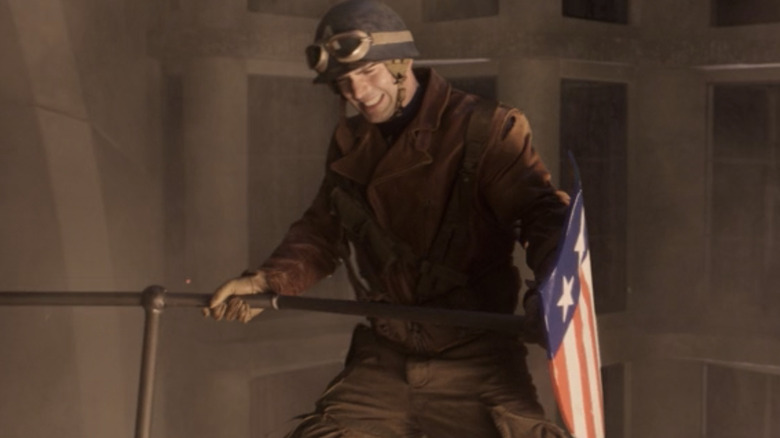Questionable Things We Ignore In The Captain America Movies
It's no secret that Captain America has become one of the most popular heroes in the modern age of cinema and something of a household name in recent years — though after the Marvel Cinematic Universe spent over a decade developing Steve Rogers into a relatable and lovable hero, it's also not surprising. A "man out of time," Steve was originally a bit rigid, still mentally stuck in the world of the 1940s rather than adapting to his new life in a post-9/11 America. This would change by "Captain America: The Winter Soldier" and would culminate with Steve fighting a younger, more traditional version of himself in "Avengers: Endgame," reminding us of how far he's come.
After all of that, Steve gets his happy ending, which, while well-deserved, has not been without its own bit of controversy. It must be admitted that for all the good that Cap has done and all the moments that made audiences go wild (looking at you, Mjølnir), some pretty questionable things occur in the "Captain America" trilogy that need to be addressed. While Cap's movies are among the most solid of the MCU film franchises, there are still quite a few moments that have us scratching our heads.
Steve is the only super-soldier test subject
In his first MCU outing, "Captain America: The First Avenger," Steve Rogers is handpicked for Project Rebirth — a super-soldier program under the direction of Dr. Abraham Erskine — because he is "a good man" whose selfless heroism makes him stand out among his contemporaries. While Steve being selected for Project Rebirth makes a ton of sense, it does seem odd that only one person was chosen in general. It wasn't entirely clear whether Steve's body could handle the procedure. Wouldn't you want at least one healthy soldier testing the serum too, just in case? For that matter, wouldn't you want multiple participants in the experiment, all carefully selected, so that you could see what happened when the procedure was applied to different people? Having only one subject is just bad science, especially when you consider that the SSR's ultimate goal was to create an army.
We know from future "Captain America" films and the most recent Marvel animated series, "What If?..." that Bucky Barnes and Peggy Carter would have been just as effective with the super-soldier serum, if not more so. With the SSR's access to the entire U.S. military and presumably other Allied forces as well, it's hard to believe that Steve was the only truly "good man" for the job. That seems like a massive oversight. Plus, if they'd tested the serum on multiple subjects, the SSR would at least have had a small team of super-soldiers at their disposal after Erskine's death instead of just one (and we would have absolutely watched that spin-off show).
SHIELD recruits Zola
After World War II ended, the United States of America drafted dozens of Nazi scientists into U.S. military programs via Operation Paperclip. One of these scientific minds was Arnim Zola, HYDRA's top researcher until his capture by Captain America and his Howling Commandos, the man who weaponized the power of the Tesseract for the Red Skull. Having become a part of the SSR and later SHIELD, however, Zola used his newfound resources and technology to conduct the torturous experiments that turned Bucky Barnes into the brainwashed cybernetic assassin known as the Winter Soldier. He also re-started HYDRA right under SHIELD's nose — because of him, HYDRA's influence would infect SHIELD for decades, fueling chaos and terrorism across the globe, convincing the people of America and the wider world to give up their freedoms for greater security.
All this failed when Captain America, Black Widow, the Falcon, and Nick Fury exposed HYDRA in "Winter Soldier," which resulted in the (extremely temporary) dissolution of SHIELD, but it could have easily been avoided entirely if Zola was properly managed or, better yet, never drafted into SHIELD in the first place. It's hard to understand how people like Peggy Carter and Howard Stark could have allowed such an oversight, but maybe Zola was just a really good actor.
Cap works for SHIELD post-Avengers
In "Winter Soldier," we see Captain America working alongside SHIELD operatives on covert missions across the globe. This doesn't seem like much of an issue on the surface, but if you think about it, it's a little out of character. After being unfrozen, Steve Rogers was quickly thrust into the intergalactic skirmish chronicled in "The Avengers," during which he and the other heroes discovered that SHIELD director Nick Fury had been manipulating the team from the beginning, hiding information on their plans to weaponize the Tesseract (yes, HYDRA was still covertly infiltrating SHIELD at the time, why do you ask). Steve rightfully saw this as a continuation of the Red Skull's work and objected, though nothing really seemed to change.
Steve would spend the next few years working with SHIELD under Fury's orders, all animosity seemingly forgotten — but what's worse is that he does so even after learning that Fury was again developing secret weapons via Project Insight. When Fury tells Cap to "get with the program," Steve tells him not to hold his breath, and as expected, Project Insight is hijacked by HYDRA to take out all their enemies (including the President of the United States). Thankfully, Captain America is able to save the day, but all this begs the question: Why he was willing to work with them for so long in the first place, especially when he knew Fury had a habit of lying to him going back to their first meeting?
Steve hides vital intel in a vending machine
Speaking of SHIELD secrets, after Fury shows up at Cap's apartment with classified intel (only to be shot by the Winter Soldier), Steve takes it upon himself to hide the SHIELD drive he's been given right in plain sight. Where, you ask? Behind some bubble gum sticks in the hospital vending machine, right across the room from where Fury faked his own death. Not the best plan, Steve. We're sure he thought it was a clever way to keep it out of the hands of rogue SHIELD agents (who are secretly HYDRA), but it doesn't really make a lot of sense. Steve puts the drive in the vending machine while there are dozens of SHIELD/HYDRA agents around him (who somehow don't notice), and shockingly, when he comes back to retrieve it, it's gone.
Thankfully, it turns out Black Widow was the one who took it, and the pair would work together to uncover the government organization's dark secrets, but Steve's negligence with SHIELD data is not only highly irresponsible, but downright dangerous. That information nearly cost Nick Fury his life and would eventually be vital in exposing HYDRA and taking down SHIELD. What's more, had it gotten into HYDRA's hands, they would have been able to use Project Insight to kill hundreds of innocents before anyone even knew what was happening. Find a better hiding place next time, Cap.
Steve pulls Sam Wilson back into war
As HYDRA reared its ugly, multiplying head, Cap and Black Widow had no one to turn to for help — except Sam Wilson. "The Winter Soldier" establishes early that Sam works with the U.S. Department of Veterans Affairs to counsel veterans suffering from PTSD, helping them get back to functioning in the world. Sam also reveals that he lost his Air Force wingman on a rescue mission, which led to his premature retirement from the military. Instead, Sam chose to use his talents to help get people back on track and work through their trauma. And yet, in spite of all that, Steve brings trouble straight to Sam's doorstep, openly talking about classified SHIELD information with a civilian and putting Sam's life, and the lives of his family, at risk.
Of course, Sam immediately offers his assistance, handing Steve his "resume" in the form of the EXO-7 Falcon wingsuit. It's worth noting that Steve initially rejects Sam's offer to help, citing that Sam got out of the military for a legitimate reason, but it doesn't take much pushback before Steve gives in. Had Captain America not shown up on his doorstep at all, Sam would have never winged up as the superhero Falcon, joined the Avengers, or become the next Captain America himself. While we love Sam and his heroic journey (with hopefully more to come), it's highly questionable for Cap to pull a retired soldier back into the field without a second thought.
Steve kisses his niece
Okay, so Steve didn't technically kiss his own niece (at the time), but after his journey back to the 1940s in "Avengers: Endgame," living his life to the fullest with Peggy Carter, Cap is now technically Sharon Carter's uncle, which ... yikes. That aside, the biggest issue here is that no matter the time period he's in, Cap is clearly not over Peggy Carter. This, among other things, makes his shared kiss with Sharon Carter in "Civil War" pretty strange. In "Winter Soldier," Steve visits an elderly Peggy, still looking at her with the same adoring expression he had decades ago. This is followed up with a Wanda Maximoff-induced fever dream in "Avengers: Age of Ultron" that also reminds us of Steve's lost love. The fact that he never got to be with Peggy still haunts him, and it weirdly makes sense that he's attracted to her niece — though Steve doesn't learn about that relationship until Peggy's funeral.
Though Sharon helps Steve, Sam, and Bucky escape the country with their gear in tow, their unforeseen kiss feels a bit exploitative. Each has just suffered a major loss here — Sharon has lost her aunt, and Steve has lost Peggy yet again. Neither of them seem quite ready to be starting a relationship — which might be why they never do. After Steve ghosts Sharon for the past in "Endgame," she's forced to move on, eventually appearing in a very different capacity in "The Falcon and the Winter Soldier."
Iron Man lets the Avengers rot in prison
As if starring in his own trilogy and multiple "Avengers" films weren't enough, Tony Stark is a central character in "Civil War," the finale to Cap's trilogy, ultimately splitting the Avengers and going head-to-head with the first one. After a thrilling airport fight scene between the two warring factions of heroes, the members of Cap's team (sans Cap himself and Bucky Barnes) are imprisoned at the Raft, a supermax facility for superhumans in the middle of the ocean. Tony visits them, berating Hawkeye and trying to get information on Steve, but also admitting that he didn't know they'd be put in the Raft, of all places. But he doesn't so much as lift a finger to help them out, either.
In fact, Tony convinces Sam Wilson to feed him information on Cap and Bucky's whereabouts before jetting out to go find them. Apparently Tony is completely comfortable with letting superheroes who have saved countless lives over the years suffer in an ocean prison for as long as Secretary of State Thaddeus Ross deems necessary (and seemingly without any sort of trial). Of course, Tony is on the "right side" of the law, but while his work as Iron Man raises his status to that of a hero, leaving his fellow Avengers to rot in the Raft makes him feel a bit more like a villain — which, in this movie, he sort of is. Thankfully, Steve breaks them all out by film's end.
Steve's superpowers change over time
Nothing is less consistent in the "Captain America" trilogy than Steve Rogers' superpowers. In "The First Avenger," Steve struggles to bend a metal pipe out of his way before jumping across an exploding factory, yet in "The Winter Soldier," he jumps out of building and lands on his shield without so much as a broken arm or a scratch. By the time the ending of "Civil War" comes around, Cap and Bucky are fighting Iron Man in a battle where Cap doesn't so much as bruise his hand against Stark's metallic armor, though when Iron Man punches back, he bleeds. The battle actually takes a real toll on Steve, who can barely stand near the end of the fight.
Of course, the opening of "The Winter Soldier" seems to imply that Steve has some sort of superhuman strength and stamina when going up against common thugs, easily kicking them across the room. In contrast, only minutes later, when fighting against Batroc, Steve and the French assassin seem to be pretty evenly matched. The vagueness of Captain America's superpowers (if you can call them that) is pretty frustrating, and somewhat hard to track given that he often takes on others with superhuman abilities. How does Cap go from struggling to bend a pipe to single-handedly keeping a helicopter from flying away? Your guess is as good as ours.
